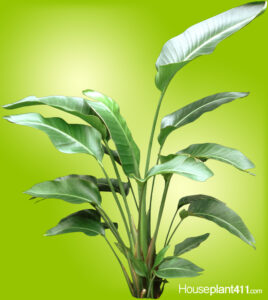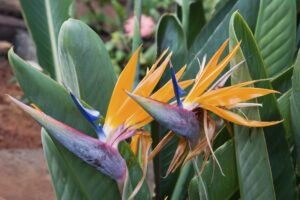Bird of Paradise Care When Indoor Houseplant
Hello. I recently bought what I thought was an indoor plant that I believe identifies as a white bird of paradise. I really liked the way it looked and how much space it would take up in my apartment was perfect. They told me it would be fine in low light (not true!). My apartment is bright all throughout the day but I don’t know that its direct sun light. I never use the A/C in my apartment and my living room stays pretty warm. So what are my options as of right now? I thought about maybe buying a light specifically for it if I need to or will it be fine in my living room? I looked at some online pictures of the white bird “bird of paradise” and it looks just like it but minus the flowering part. Any help would be great.
Hi Dee,
It does sound like they sold you a Bird of Paradise plant that is the outdoor variety. The indoor houseplant variety never blooms! Here is a picture of the indoor Bird of Paradise Plant.

Here is the outdoor Bird of Paradise in bloom.

If you plan to keep the plant (you can return it to Home Depot & they will refund your money) you need to put a Bird of Paradise Plant in very bright light. It can even be placed in the direct sun if you do it gradually and allow the leaves to slowly adapt. You may have to move the Bird of Paradise plant to different areas of your home as the seasons change in order to give it adequate light. Placing it close to a south- facing window would be best. A Bird of Paradise plant grows best in temperatures between 65°-75°F (18.3°-23.9°C) during the spring, summer, and fall. In the winter, when the plant is “resting,” keep the temperature 10° cooler. Temperatures below 50°F (10.0°C) cause the leaves to curl and turn black. Feed monthly in the spring and summer when a Bird of Paradise is actively growing; use a balanced plant food diluted to 1/2 the recommended strength. Never fertilize a Bird of Paradise plant in the fall and winter when it is resting. Excess plant food deposits salts in the soil and these salts cause leaf tip burn. In the spring and summer keep the soil moist but never soggy. A Bird of Paradise plant needs less water in the fall and winter. Water from the bottom so the soil stays loose and remains well aerated. Water that has a high salt content burns the leaves.
You can read more about how to care for a Bird of Paradise as an indoor plant in the Popular HousePlant section of the website.
https://www.houseplant411.com/houseplant/bird-of-paradise-plant-care-tips
